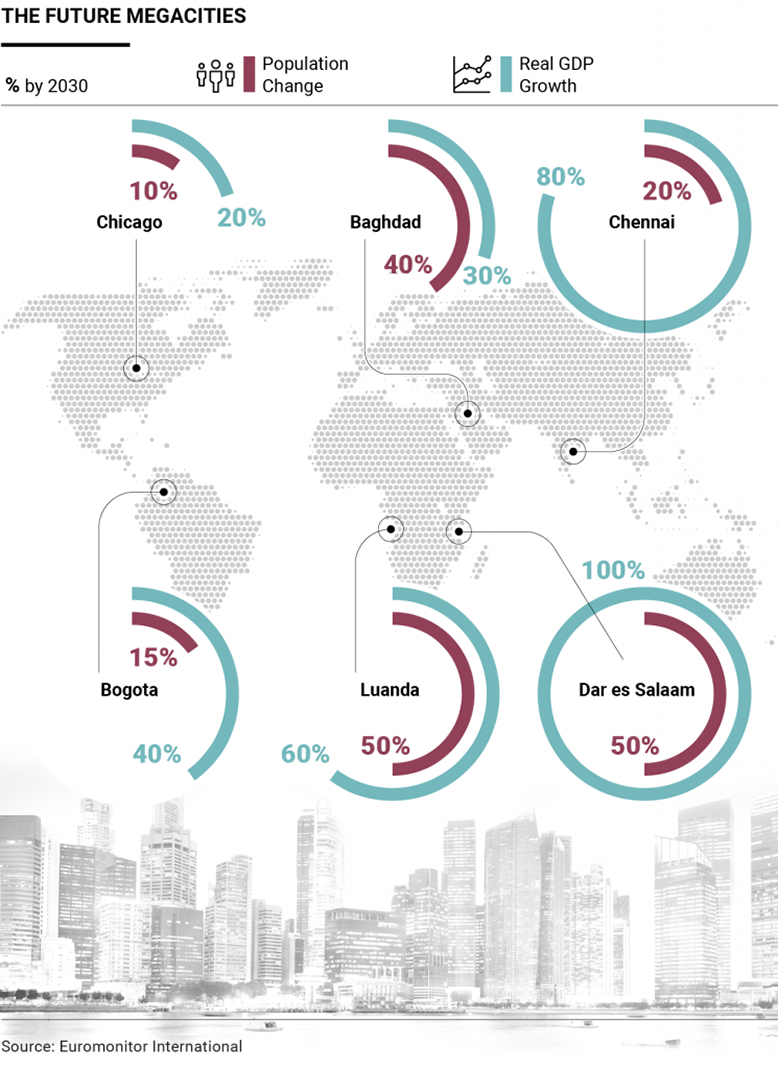
Six new megacities
by 2030: Chicago,
Bogotà, Luanda, Chennai, Baghdad, Dar es Salaam. The trend towards increasingly
larger cities shows no signs of stopping, as the world’s growing
population keeps flocking to urban areas.
This seemingly unstoppable phenomenon started slowly at the beginning
of the 1900s, when 15% of the global population lived in cities, large and
small. That number is seen reaching 60% by 2030.
This tendency towards concentration has led to the emergence of the “megacity,” huge urban agglomerations with more than 10 million inhabitants that rely on infrastructure to guarantee the coexistence of all these people. Roads, subways, railways, bridges, but also schools, hospitals and other public services are vital to making these cities liveable and sustainable.
The number of megacities is expected to grow from 33 to 39 by 2030, becoming home to 9% of the population and producing 15% of the world’s gross domestic product (GDP), according to Euromonitor International, the research firm that conducted a demographic study looking at the next 10 years and picked out six cities destined to become megacities by 2030.
Six future megacities: will they be among the most populous cities in the world?
Chicago
For years, Chicago has witnessed a steady growth of its population, linked to its role as a transport hub for the United States. In the coming years, its population will exceed 10 million inhabitants, leading it to enter the megacity category and winning first place among the new megacities in terms of GDP equal to $595 billion in 2030.
Bogotà
Bogotà is destined to enter the ranks of the world's largest cities in the coming years, following in the footsteps of other cities in Latin America such as Mexico City, Lima, Rio de Janeiro, and São Paulo. Its GDP is an estimated $109 billion.
Luanda
This is the city with the highest population growth rate. By 2030, the number of residents of this large African city will increase by 60%. But it will not be enough for them to overtake Cairo, the continent’s biggest megacity with an expected 29.8 million inhabitants.
Chennai
Located in the Bay of Bengal in eastern India, Chennai will be among the newest megacities with the highest population density. Although it is growing fast, its economy is limited, producing just $50 billion each year by 2030.
Baghdad
Iraq’s largest city is already at eight million inhabitants, and its steady growth means that by 2030 it will exceed 10 million and join the megacity list.
Dar es Salaam
Tanzania’s largest city has a high population growth rate, almost reaching Luanda’s records. This lively city will have a low GDP at just $5 billion, but one that is constantly growing.

Megacities in the developing world
Although New York was the first megacity in history, exceeding 10 million inhabitants in 1950, the new behemoths are clustered in developing countries.
Of the 33 megacities on the planet, 26 of them are in developing countries - and so are five of the six megacities that will be created by 2030.
The largest number is concentrated in the Asia Pacific region, home to 19 of the 33 megacities. China and India lead the way, with six and four megacities, respectively.
Newest megacities are dwarfed by the largest
These soon-to-become megacities do not threaten to usurp the throne of the world’s largest.
In 2030, Jakarta will be the world’s largest megacity, with a population of 35.6 million people, surpassing Tokyo, now ranked first, which will lose ground as its population ages. Osaka, meanwhile, will become the megacity with the highest number of people over 65, or 31% of the inhabitants.
Lagos will see the highest rate of population growth, while Dhaka, Manila and Bangalore will see the greatest development as these cities economies double in size. This considerable but not always well-controlled development in many cases may risk fueling marginalisation and poverty. For example, the development of Lagos, in Nigeria, is contributing to the birth of Makoko, the largest slum in the world with a population destined to reach 400,000 people.
The richer megacities are growing, but the poorer ones are too -- so income inequality is destined to increase. In 2030 the average per capita GDP in megacities in developed countries will be four times greater than in developing countries.
This income inequality, however, does not stop people from flocking to these big cities to seek or enjoy their fortunes.


